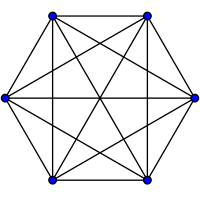I was wrong.
This blog is a small experiment in writing down the things I have learned recently as, once again, I decided to investigate different aspects about the game. You may think of this as a kind of lab notebook, which is bound to show wrong assumptions, meandering "rabbit-trails" where I go way off topic, and maybe the occasional insight into the game, game theory, or possibly programming. I don't expect to have a whole lot of people following such a blog as this, but should anyone stumble across it, welcome!
As this is an introduction, it seems reasonable to present the basic Game of Sim. You can grab a piece of paper, draw six dots in a hexagonal shape, bring in a partner to play against, and you are ready to go.
Figure 1-1
Figure 1-1 above shows the "empty" version of the board that I will use to show moves throughout this blog. The "dots" are numbered for easy reference.
Things go very well if you have two different-colored pens or pencils--one for each player--but it works fine to alternate solid lines and dashed lines, too. The two players take turns drawing lines between the six dots (or vertices) of the hexagon with their color.
Figure 1-2
Figure 1-2 above shows a game in progress; the player with the blue pen went first and a total of seven lines have been drawn so far. A "major" triangle is formed from three lines that connect the numbered vertices (interior triangles don't count). For instance, there is one major triangle in Figure 1-2, between vertices 2-3-4. It has two blue lines and one red line. The object of the game is to avoid creating a major triangle with only your colors. The first player to create a monochromatic major triangle loses the game. For instance, continuing the game above, the players might come to the following point (Figure 1-3), where the "blue" player is about the draw the last available line:
Figure 1-3
With only one line left, the blue player will be forced to create a major triangle of his own color. In fact, in this case, with one line he will create two monochromatic major triangles, 1-2-4 and 1-4-6.
Figure 1-4
Sometimes we will highlight the losing major triangles so they are easier to see, as in Figure 1-5:
Figure 1-5
There is already quite a bit about this game on the internet, but I have not yet found a such a useful strategy. One goal of this blog is to find this elusive strategy, but more compelling (to me, at least) is the chance to use this game to learn many new and interesting things. You are most welcome to tag along as we wander down the road of discovery!
[1] Gardner, M. Mathematical Games, Scientific American, February (1973), pp. 108-112
[2] Simmons, Gustavus J. "The game of SIM," J. Recreational Mathematics, 2(2), 1969, pp. 66.






Out of curiosity, didn't the blue player lose in the third image? There exists a monochromatic triangle made from lines 5-6, 6-4, and then the intersection of 6-4 and 5-3. Similar situations exist on other lines as well.
ReplyDeleteMy guess is that the end game condition occurs when lines drawn on the possible move lines create a triangle, and not when lines intersect. Is that correct?
You are quite right about there being an internal monochromatic triangle in Figure 1-3. I have played the game so long that I don't even see the internal triangles anymore. I have re-edited this first post to introduce the concept of "major triangles," that is, those triangles whose vertices correspond to the numbered vertices of the hexagon (I also introduced figure numbers). Or, as you put it, the end game depends upon monochromatic triangles comprised of entire lines ("move lines") between the numbered vertices. Thanks for the clarification!
Delete